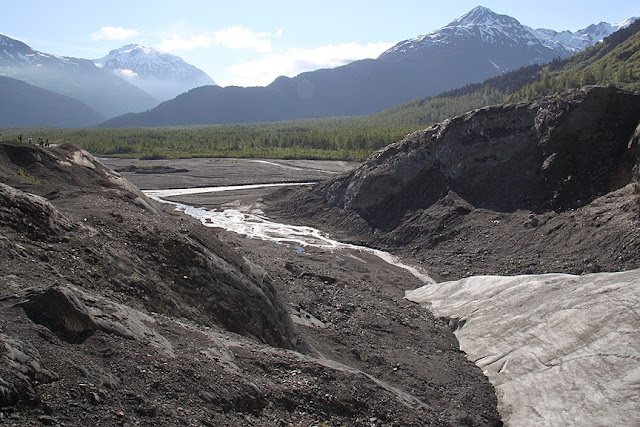The drive from Seward to Wasilla was punctuated by several stops for birding. Traveling up along Turnagain Arm, a branch of Cook Inlet, we stopped at a roadside park where a creek flowed under the road, and found a pair of fledgling American Dippers sitting on a log. We never did see an adult. If you're not familiar with the dipper, it is the only aquatic songbird in the U.S. That's right--the dipper feeds entirely on what it catches underwater clean, swift-moving streams, which is about the craziest thing I've ever heard. (If you'd like to see the bird in action, follow this link. Notice how the bird nearly always faces upstream.)
 |
| Immature American Dipper waiting for lunch. |
We made another stop near Anchorage, at what I think was a ski park, and walked the trails there after having lunch. I don't recall exactly what we were looking for, but I got another great look at what was one of my target birds, the Boreal Chickadee. I'm pretty sure nothing so cute has ever lived.
 |
| Boreal Chickadee posing. |
The big birding spot of the day was Westchester Lagoon in Anchorage. This pretty, public park surrounds a large pond which has a small island. It was in the 60's, sunny, but breezy. Even so, the Alaskans were out in number, dressed in shorts and t-shirts and enjoying the sun. You could tell us apart from them because we were all in jackets and long pants.
 |
| The man-made lagoon is a waterfowl sanctuary. Downdown Anchorage and the Chugach Mountains frame the park. |
Right off we got great looks at an Arctic Tern sitting on a post near the boat launch.
 |
| Arctic Tern. I love how tiny their feet are in relation to those long wings and tail. |
A mother Mallard took to the water with her brood as we approached.
 |
| A Mallard hen with chicks because who doesn't love chicks? Like the sign on the Kachemak Bay boat tour said, they're all good birds. |
Bill pointed out a small flock of Hudsonian Godwits resting on the shore of the island. The lighting was terrible for photos but I was excited anyway as these were a new bird for me.
 |
| Hudsonian Godwits with a Herring Gull. |
While there wasn't the abundance of waterfowl that Bill would have like to have seen, what was there was pretty close to shore, probably used to being fed. I got some nice shots of a Lesser Scaup preening.
 |
| Lesser Scaup preening. |
This pair of Greater Scaup floated by too.
 |
| Greater Scaup. They are differentiated from the lesser primarily by head shape as well as size. |
A Gadwall also made an appearance near to shore. While none of these were new to me I was quite happy to get some really nice up-close photos.
 |
| Gadwall drake. |
We finished the day with a drive up to Wasilla, where we stayed at the Best Western on Lucile Lake. After dinner I crashed on the shore, utterly worn out. The short nights and busy days were starting to get to us all. I really wanted to climb in a canoe and paddle to the middle and sleep. We saw Lesser Yellowlegs on the hotel dock and several pair of nesting Red-necked Grebe, and heard Common Loons calling from across the lake. It was a picture-perfect evening.
Next: We travel up to DENALI!!





















